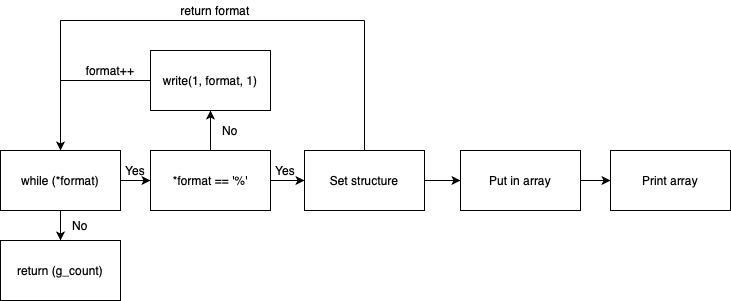Objectives
int ft_printf(const char *, ...)
- Without buffer management
- cspdiuxX%
- flags will be only contain -0.*
What to know
Variable argument
- #include "stdarg.h"
- When you want to have function which can take variable number of arguments.
- The last argument of a function (...) will be variable arguments.
va_list ap;
- Need va_list type pointer to read arguments stored in stack.
va_start(va_list ap, last);
- Initializes ap, which can be passed to va_arg() for each argument to be passed.
- Each call to va_start must be matched by a call to va_end(), from within the same function.
- The parameter last is the name of last parameter before the variable argument list.
va_arg(va_list ap, type)
- The parameter ap is initialized by va_start.
- Each call to va_arg modifies ap so that next call returns the next argument.
- The parameter type is a type name of value that ap points.
char c = va_arg(ap, int);
char *s = va_arg(ap, char *);
long long p = va_arg(ap, long long);
int di = va_arg(ap, int);
unsigned int uxX = va_arg(ap, unsigned int);- If you pass integral value with conversion rank smaller than int (e.g. char, bool, or short), it will be converted to int.
va_end(va_list ap);
- Signals that there are no further arguments, and ap will be invalidated.
Basic format of ft_printf
%[flags][width][.precision]type
Flags
- Default is right adjustment of the output with blank-padding.
-
- Left adjustment of the output.
0
- Zero-padding
- '-' overrides '0' if both are used.
Width
- An optional digit string specifying a field width.
- If the output string has fewer bytes than the field width, it will be blank-padded on the left (default) to make up the field width.
- * will read variable argument.
Precision
- Optional period, '.', followed by an optional digit string specifying the maximum number of bytes to be printed from a string.
- If the digit string is missing, the precision is treated as zero. ( . == .0)
- * will read variable argument.
- Negative precision is treated as no precision.
- char type and pointer type do not take precision.
-> 출력을 멈추고 -1 을 리턴하게 구현함.
Apply precision first, then compare with width.
Implementation

- A return value of ft_printf is the number of characters printed.
-> Used global variable g_count for easier approach.
Set structure
typedef struct s_option { int flag_minus; int flag_zero; int width; int dot; // to know if there is precision int precision; // initially set as -1 instead of 0 int flag_pre_va; // if precision is a variable argument int num_m; // is number negative? char type; } t_option;
- Used structure to hold several data items of the same kind.
- Precision is initially set as -1 because zero precision and negative precision (which is considered as no precision) are different.
- flag_pre_va is for distinguishing certain cases when obtaining precision from variable argument as -1.
-> printf("%.d\n", 0) => $
-> printf("%.*d\n", -1, 0) => 0$ - Returns last pointer to main function.
Put in array
- Each type has quite different formatting based on flag, precision, and width.
- Divided into three functions based on where to pad: left_blank, left_zero, and right_blank.
- Malloc final array to be printed.
Print array
- Print array and increase g_count.
- Free array.
What to be careful
- Know each type has different approach
-> When handling with diuxX, precision length only matters when it is longer than diuxX. (Will be zero padded)
-> S will be cut when precision length is smaller. - Know special cases such as NULL and error.

You just need to tap to jump or hold to fly (in the spaceship segments), avoiding collisions with spikes, traps, and gaps along the way. Each Geometry Vibes level is fast-paced and perfectly designed in sync with electronic music, requiring players to have good reflexes and a precise sense of rhythm. Each time they collide, players will have to start over from the beginning, creating an experience that is both addictive and challenging.